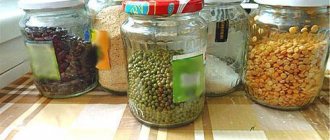Coconut oil is a versatile and healthy product. It can be used as a cosmetic for skin, hair and nails, and can be eaten by frying organic vegetables, meats and adding it to porridges. It is not capricious in storage, but you still need to follow certain rules so that the oil does not lose its properties before the expiration date. The article provides details on how to store and select coconut oil.
How to choose coconut oil
A product with a pronounced odor, sediment, or the presence of preservatives or flavorings is not worth buying.
Natural oil differs from fake oil in its thick, homogeneous consistency, which turns into a solid state at temperatures below 24°C. It is bottled in glass bottles or plastic containers labeled “BPA free.”
Straw color is a sign of low-grade marc. It is recommended to buy a liquid product with a golden hue, and a solid product with a milky color.
Conscientious manufacturers put the following marks on the label:
- about the content of 100 percent oil in the package;
- spin method (hot or cold);
- manufacturer's name;
- date of manufacture;
- shelf life.
To check the naturalness of the oil, apply a drop to your hand and rub in. The fake forms a sticky film, while the natural squeeze leaves no trace.
Refined
A refined product is distinguished by the inscription on the label “Refined coconut oil or RBD”. Copra extract undergoes multi-stage processing. After intensive cleaning, the nutty taste and aroma disappear, but valuable triglycides are preserved, and the smoking point increases.
The best is considered to be organic, refined, cold-pressed oil made in the countries of South and Southeast Asia.
Unrefined
An unrefined product is purified only from mechanical impurities. The completely preserved composition determines the creamy nutty taste, golden color, and coconut aroma.
Note! The premium class includes oil marked “organic”. This means that the raw materials are grown without chemical fertilizers or growth regulators.
Only certified products receive the ORGANIC mark. If there are no special marks on the packaging, except for the Coconut Oil inscription, there is a high probability that the product is made by hot pressing, which partially loses the beneficial substances.
Cooking method
In Asian countries, where coconuts cost mere pennies, oil production is carried out by small family factories and large industries. Many people mistakenly confuse it with the clear liquid found inside the nut. Others think that it is the liquid squeezed out of the pulp shavings. However, this is nothing more than milk from which butter is extracted.
Butter can be made in two ways:
- boiling;
- cold pressed.
In small factories where there is no special equipment, milk is boiled. As a result, the liquid coagulates, turning into a thick brown mass with a clear golden liquid. It is the liquid that is the valuable oil that you can extract at home.
However, a more useful product is obtained by cold pressing, because it cannot be heat treated and retains all trace elements and vitamins. When buying medicinal or cosmetic oil, pay attention to the packaging. It should indicate that the product is made by cold pressing. It lasts longer and contains more useful components.
Signs of spoiled coconut oil
Coconut pomace deteriorates due to the oxidation of fatty acids under the influence of bright lighting and contact with oxygen. The product is hazardous to health and must be disposed of if:
- moldy film on the surface;
- rancid taste;
- color change to yellow;
- musty smell.
The expiration date does not mean that the oil cannot be used in everyday life. If there are no signs of deterioration, the product is used to make hair masks, use it as a cream for feet, hands, soften cuticles, or as a means for rubbing furniture and leather shoes.
How to store at home?
When oil is stored for a long time and incorrectly, the following happens: the product gradually oxidizes, its composition changes, and valuable properties disappear. As a result, the product becomes completely unusable.
To ensure that the oil does not lose its properties throughout its shelf life, it must be properly stored and used for this purpose in appropriate containers.
Features of storing coconut oil
To ensure that the oil retains its freshness and taste, after opening the package, the product should be placed in the refrigerator. In this case, you must follow these rules:
- For unrefined oil, keep the temperature at + 5-8 degrees. The refined product should be stored at a temperature of +25 degrees.
- Humidity parameters should be 65%.
- You should choose storage containers. It should be opaque. Plastic dishes are also suitable.
- The lid should fit snugly against the edges of the container.
If storage rules are violated or stored at temperatures below +5 degrees, the quality of the oil will significantly deteriorate. The following signs indicate damage to the product:
- the appearance of bitterness and unpleasant aroma;
- change in oil shade: the solid product loses its white tint;
- product layering – lumps and grains form;
- loss of transparency of liquid oil;
- the appearance of mold on the surface.
Storing a Home Product
Making homemade butter is quite easy. About 30 ml of the finished product is obtained from a medium-sized coconut. Grate the walnut pulp on a fine grater and squeeze through cheesecloth. The white liquid is coconut milk, which is sometimes confused with the water inside the nut. The milk is simmered over low heat until it begins to darken. The mass is divided into lumps and a transparent brownish liquid. After cooling, the contents of the pan are squeezed through cheesecloth to obtain oil.
Pour the squeezed oily liquid into glass bottles with a gradient. It is advisable to close them with lids that do not let air through. The use of plastic containers is strictly prohibited. Homemade oil should be used within 2 weeks of preparation.
Food storage
Products must be stored in the refrigerator. For food, only hot-pressed oil is used (you can also prepare it yourself using the recipe described above).
Despite the long periods and unpretentious storage conditions, you should not stock up on a huge amount of bubbles overnight. The fresher the product, the healthier it is.
Temperature
The ambient temperature affects the hardness of coconut oil: at + 25⁰С and above it becomes liquid and fluid, at +10 – +24 – gelatinous, at + 10 °С and below – it hardens. For everyday use and ease of use, it is best to store it at high temperature.
The permissible range is from +5 to +25 degrees. The number of degrees is not as important as the presence of differences. It is sudden changes in temperature that lead to premature spoilage of the product.
Coconut oil can be stored in the refrigerator. When using, separate the required amount from the total mass and place the container in the cold again. The removed part must be kneaded and warmed in your hands before use. You can dissolve the contents of the jar and pour it into another container, holding it under running hot water for some time.
Do not manually remove cold oil from the jar. Use a clean, dry spoon to separate the required volume and immediately close the container.
Humidity
A high concentration of water vapor in the air contributes to premature deterioration of oil, especially in the hot season and with regular temperature changes. Although the packaging is sealed, the product should not be left in the bathroom unless it is intended to be used for a short period of time.
Opening the container in a humid environment allows pathogenic microflora to penetrate the oil.
Effect of light
One of the conditions for maintaining freshness during the warranty period is the absence of light. To prevent coconut oil from oxidizing at home and starting to taste bitter, it should be stored correctly, that is, in the dark. Direct sunlight is especially harmful to the product.
Storage containers
After opening the original packaging, you should decide how and at what time the product will be used, choose the method and place of storage. If a person plans to use it for different purposes (for dressing salads, as a cosmetic, etc.), it would be more appropriate to pour the contents into several jars. It is more convenient to store it where it will be used: in the kitchen cabinet, on the shelf in the bathroom, in the bedroom or on the nightstand in the hallway.
Good quality coconut oil is best stored in a dark glass or porcelain container with an airtight or screw-on lid. These materials do not come into contact with the product and allow the contents to remain fresh and healthy for longer.
Do not store coconut oil in plastic or metal containers for long periods of time.
After opening the original packaging, the product becomes vulnerable to the destructive effects of the external environment. High humidity, bright light and air are dangerous for him. Therefore, coconut oil must be stored in a dark, dry and cool place, always in an airtight container. If all conditions are correctly observed, the quality of the product will remain unchanged for a long time.
After opening the package
After opening the sealed package, the product begins to be exposed to the destructive effects of the environment, water vapor and bright light; air containing bacteria becomes dangerous for it.
Therefore, it is best to store it in a dry, dark and cool place, always with the lid tightly closed. If the correct storage conditions are observed, the product remains of high quality for a long time.
Beneficial features
Coconut juice, which contains 80% triglycides, is a source of energy. The calorie content of 100 g of product is 899 kcal. Lauric and caprylic saturated fatty acids in the composition increase the level of “good” cholesterol, prevent the development of heart failure and vascular pathologies.
Other benefits of coconut oil:
- gives a feeling of quick satiety, suppresses appetite;
- treats eczema, dermatitis;
- strengthens the immune defense, increases the body's resistance to seasonal colds;
- helps calcium absorption;
- partially restores the cognitive abilities of the brain in the early stages of Alzheimer's disease;
- prevents the development of hypertension;
- medium chain triglycides accelerate metabolic reactions by breaking down lipids;
- lauric acid fights bacterial, viral and fungal infections.
Coconut oil, containing vitamin E and myristic acid, maintains youthful skin and softens hair.
We recommend:
How long can meat be stored in the freezer in the summer heat?
Storage recommendations
Coconut oil (CO) is very unpretentious and does not require special storage conditions, but there are still some rules:
- If you purchased the product in plastic or metal packaging, it must be stored in a dark glass container. Transfer it immediately after opening the jar.
- Store coconut oil away from direct sunlight. A kitchen drawer, cabinet, or side shelf of a refrigerator will do.
- it is desirable to limit the free access of oxygen to the product. Seal the container well with a stopper or rubber stopper. A lot of air gets under the screw cap, which leads to rapid oxidation of the product.
- Optimal air humidity should not be more than 60%;
The original cardboard packaging of product capsules provides additional protection from sunlight - do not throw away. But the product in this form cannot be stored in the refrigerator. A first aid kit or dark box will do.
Storing coconut oil at home after opening
If the storage rules are followed, opening the packaging will not shorten the shelf life of the pomace. Coconut oil retains its consumer properties:
- homemade - 14 days;
- hot pressed - 1 year;
- refined - 2 years;
- unrefined food in the refrigerator - 1 year, on the shelf - 6 months;
- cold pressed without preservatives - 6 months;
- with preservatives - 2–4 years;
Important! If the integrity of the ampoule is damaged, the product is used within 12 hours.
Where to store opened coconut oil is up to everyone to decide for themselves. But experts recommend putting the product in the refrigerator in the summer, and in a cabinet with a door in other seasons.
How to determine if a product has gone bad
The suitability of an oil can be determined by two criteria:
- Unhealthy whitish tint and traces of mold on the oil. However, the white color should not be confused with the natural shade of the oil.
- An unpleasant, rotten or rancid odor that can occur even in oil in its solid state.
You definitely cannot use a spoiled product, as this can cause harm to the body.
When stored properly, coconut oil provides a lot of pleasure in both cooking recipes and as cosmetics.
Conditions
To preserve the beneficial composition of coconut copra extract unchanged, observe the following storage conditions:
- Temperature. The benefits of oil decrease after freezing. At temperatures below 24°C, the product changes from a liquid to a solid state, acquiring a milky color without changing its consumer properties. If it is more convenient to use the juice in liquid form, it is stored not in the refrigerator, but in the kitchen table or cabinet. The optimal temperature is 4–20 °C.
- Access to light. The product retains its benefits, taste and aroma longer in packaging that protects from sunlight. Regardless of the material of the container, the pomace is stored behind a closed door.
- Limiting exposure to oxygen. To prevent oxidation of saturated fatty acids, the container is tightly sealed after each use.
Capacity
Plastic and metal react chemically with coconut oil, so it is not recommended to keep it in containers made from these materials. The product is best stored in tightly closed jars and dark glass bottles.
Once opened, oil purchased in bulk packaging is poured into a smaller container and placed in a place protected from light.
Mold will not form on the surface if the solid butter is removed from the jar using clean, dry cutlery. You can avoid condensation in the container by placing it in a cardboard box.
In order not to doubt the freshness of the product, and not to evaluate its organoleptic properties every time, you should not buy coconut oil in large quantities and in dubious retail outlets.
Rate this post
Use in cooking
Many people know how to use coconut oil for cosmetic purposes, let’s look at how you can use it in cooking:
- coconut oil is used for preparing any hot dishes: meat, fish and vegetables, for soups, hot appetizers and sauces;
- Along with butter, coconut oil is suitable for side dishes: it can be added to mashed potatoes, pasta, rice or buckwheat porridge, and also used to dress salads;
- baked goods with coconut oil retain their fluffiness and freshness much longer;
- You can stew any vegetables in coconut oil and make a delicious stew;
- it is added to sweet milk porridges (for example, semolina, rice, millet or pumpkin);
- Coconut oil is ideal for deep-frying lovers - it does not go rancid, and therefore can be used in deep frying 5-7 times.
Source: depositphotos.com
Good news for baking lovers: recent scientific research has revealed that coconut oil is not stored in fat, but is completely absorbed. In addition, consuming coconut oil during a diet can significantly reduce the carbohydrate content in the body.
Coconut oil is a real find. Check out its beneficial properties and include it in your diet. By following simple storage rules, you can preserve its unique qualities for a long time.
What to look for when choosing?
To purchase a truly high-quality product, you need to take into account a number of features. Coconut oil comes in two types:
- unrefined - pure and natural, obtained from fresh pulp by quick drying;
- refined - heat-treated, obtained from pulp cake.
During refining, it loses most of its beneficial properties.
However, such a product is stored for 1-2 years longer. Unrefined is considered to be of higher quality. Suitable for both outdoor and indoor use.
It is also important to pay attention to other traits. Qualitative:
- quickly absorbed into the skin;
- does not leave a greasy film;
- has a sweetish aroma;
- has a light yellow or transparent tint in liquid form;
- frozen white;
- sweet to taste;
- melts in your mouth.
Thus, preference should be given to unrefined. It is considered completely natural because it has not been subjected to additional processing.
How long is the shelf life?
- Refined contains fewer natural substances beneficial to health, but it is stored longer. Under standard conditions, it is stored from one year to six months; food grades are usually stored less than medical and cosmetic ones.
- Unrefined food can be stored for six months or less. The least stored oil is artisanal oil purchased second-hand from farmers. All of this assumes that you follow the basic rules outlined in the section above.
Adviсe
Most often, an exotic bottle is brought as a beautiful gift from Asian countries - Thailand, Vietnam or India. If the container containing the product is not marked in any way and is hermetically sealed, there is no need to consider this product as a food product. If there is a label, you need to study the composition to see if it contains stabilizers and preservatives.
- If the butter was sold in clear plastic packaging, it should be melted indoors and poured into clean, dry glass containers.
- It is best stored, like any vegetable fat, in thick-walled dark glass bottles with an airtight lid.
- You can remove the product from the container only with absolutely clean objects (not with your hands!).
- It is best to pour the oil from a large container into a small one, which is topped up as you consume it.
- Never store in the bathtub or shower!
- During storage, it is necessary to periodically inspect the cap or lid of the container; the first signs of mold often appear on it.
A completely spoiled product can be used as shoe polish, parquet or furniture. It is also used as an additive to protective hand cream before gardening or housework.
RESULTS
RESULTS °ÑамеÑÑÑÑ â Ð²Ñ ÑможеÑе понÑÑÑÑ, как ÑÑани I'm sorry! RESULTS нÑÑ Ð¸Ð½ÑÑÑÑкÑиÑ: дР°Ð¶Ðµ новиÑок.
RESULTS
What's wrong? RESULTS µÐ¼Ð¿ÐµÑаÑÑнÑй Ñежим. What's wrong?
- RESULTS +5 RESULTS +25R¡;
- +25С, жидкоÑÑÑ Ð½Ð°ÑÐ¸Ð½Ð°ÐµÑ Ñа ASS, RESULTS ниже +5, Ñо безвозвÑаÑно загÑÑÑеваеÑ;
- OPTIONAL RESEARCH ROCK;
- RESULTS µÐ»ÑÐ·Ñ â иÑп¾Ð»ÑзÑйÑе ÑолÑко ÑиÑÑÑÑ Ð»Ð¾Ð¶ÐºÑ!
REPORT
ROOM I'm sorry! REPORT:
- RATIO 60%;
- RESULTS ²Ð°Ð½Ð½Ð¾Ð¹ комнаÑÑÑ;
- RESULTS smear Ñ, маÑÑа бÑÑÑÑее поÑÑиÑÑÑÑ.
СвеÑ
RESULTS RESULTS:
- RESULTS ROOM ¿Ð¾Ð²ÑÑаÑÑ ÐºÐ ¸ÑлоÑноÑÑÑ Ð¼Ð°ÑÑÑ;
- ROOM ÑÑи â жидкоÑÑÑ Ð±ÑÐ´ÐµÑ Ð±ÑÑÑÑо поÑÑиÑÑÑÑÑ, наÑÐ½ÐµÑ Ð³Ð¾ SOS.
REPORT
RESULTS RESEARCH RESEARCH вилÑной поÑÑде â Ð½ÐµÐ»Ñ·Ñ Ð²ÑбиÑаÑÑ Ð»Ñ±ÑÑ ÐµÐ¼ÐºÐ¾Ñ SS:
- RESULTS µÑеливайÑе в меÑаллиÑеÑÐºÑ Ð¸Ð»Ð¸ пР"Responsiveness;
- RESULTS, ASSURANCE ½ÑÑе ÑвеÑа;
- RESEARCH RESULTS.
RESULTS 1/2 ½ÐµÑколÑко емкоÑÑей, ÑаÑÑÑавиÑÑ Ð¿Ð¾ ÑазнÑм меÑÑам. ROOM ¸stan »ÑÐºÐ¸Ñ Ñей â коÑмеÑиÑеÑкиÑ, кÑлинаÑнÑÑ Ð¸ дÑÑ Ð³Ð¸Ñ.
Сделаем вÑвод â где лÑÑÑе ÑÑаниÑÑ ÐºÐ¾ÐºÐ¾Ñов ое маÑло!
- regurgitation;
- RESULTS ºÑÑÑкой.
RESULTS → ´Ñй мР¸Ð»Ð»Ð¸Ð»Ð¸ÑÑ Ð¶Ð¸Ð´ÐºÐ¾ÑÑи! ROOM RESULTS I'm sorry.
RESULTS CONTACT US GOOD!











